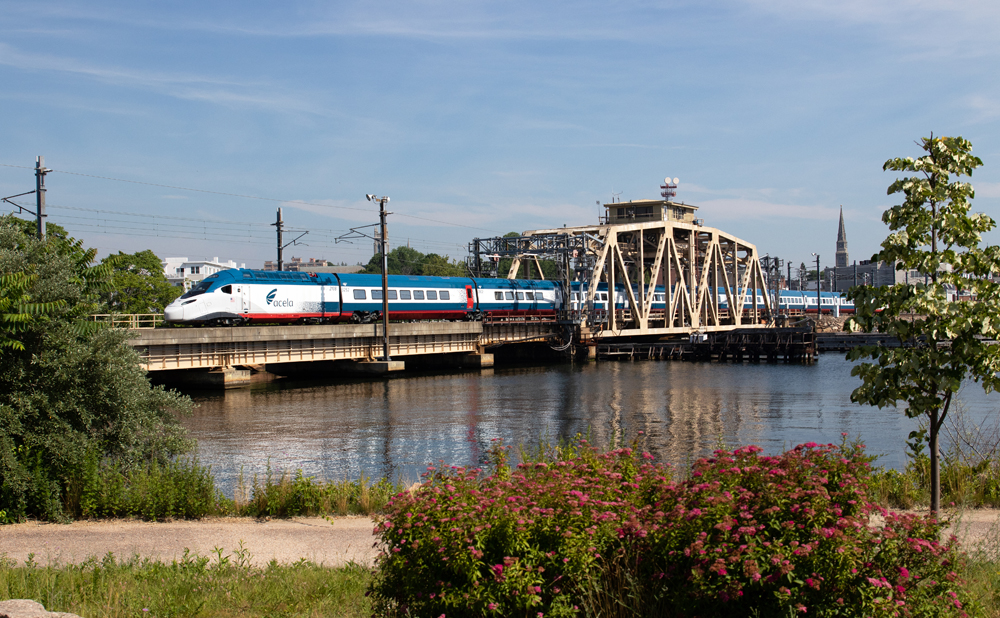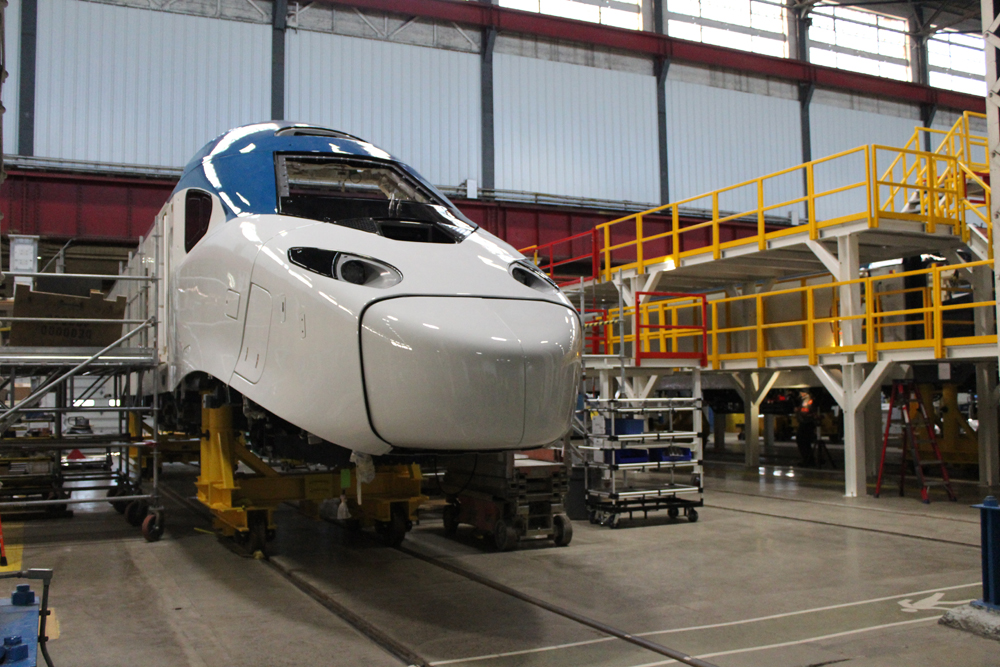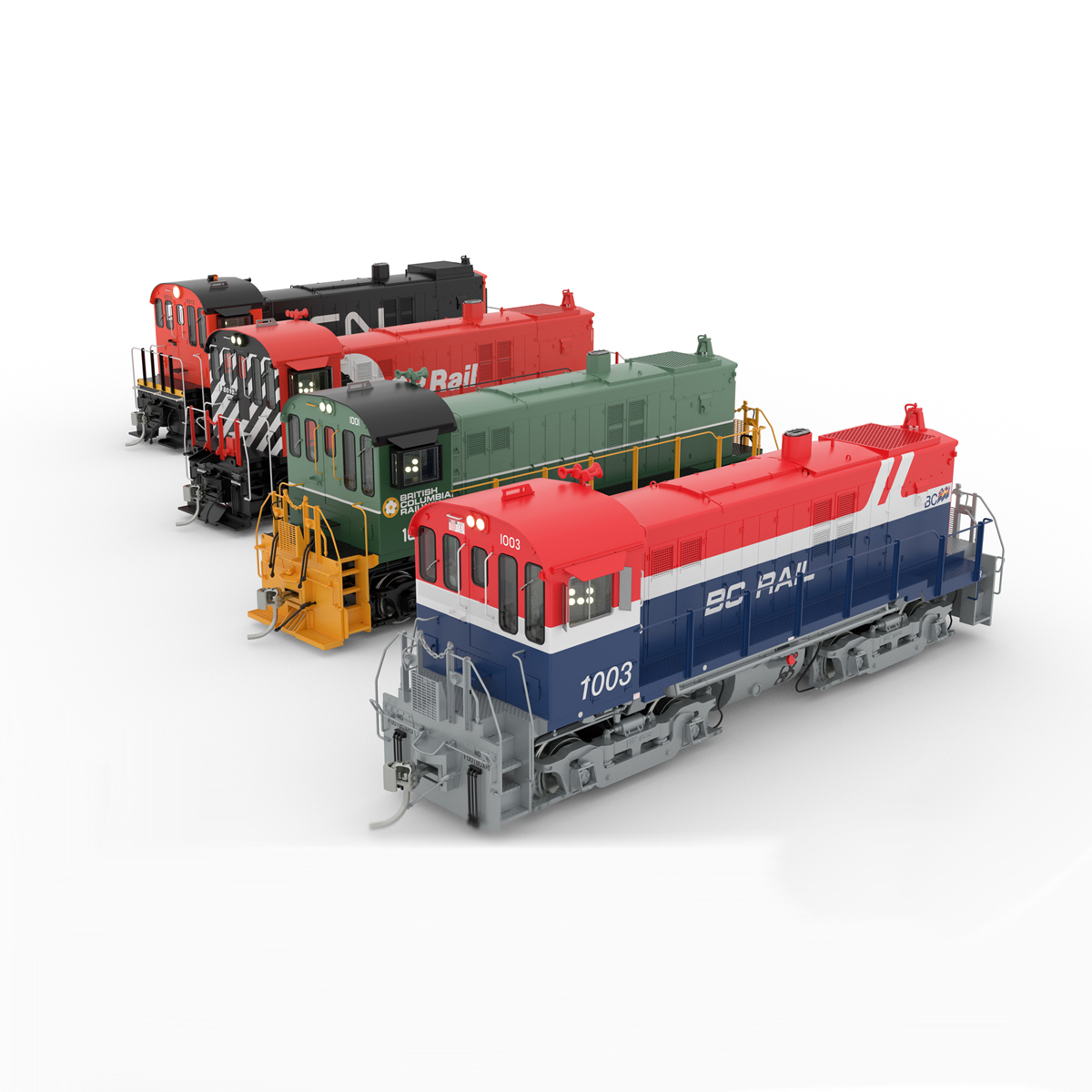
WASHINGTON — Amtrak’s Office of Inspector General today issued a report highly critical of a manufacturing process that has led to defects preventing Amtrak from accepting any of the 12 of 28 New Acela trainsets and 22 of 28 café cars already produced at Alstom’s Hornell, N.Y., facility.
The 38-page report contains redactions of monetary amounts “due to [their] sensitive nature,” so the true cost of production errors has not been revealed for what had been called a $2.45 billion project when announced in 2016.
Since Trains News Wire attended an “open house” at the Hornell plant in June 2019, Amtrak and Alstom have only offered cursory explanations for why none of the trainsets tested on the Northeast Corridor had been placed in service [see “New Acelas face further delays,” Trains News Wire, May 30, 2023.] Today’s report confirms numerous issues, including:
— Alstom trainset designs have not yet met federal safety requirements, and each of the trainsets produced has defects Alstom is required to fix or modify before Amtrak launches revenue service.
— The inability to produce a validated computer model of the equipment’s performance will result in indeterminate further delays in the start of service. Predictions of performance from the computer model must be submitted to the Federal Railroad Administration as part of the qualification testing plan before it will allow the trainsets to proceed with additional operational testing.

— Alstom built more than half of all New Acela trainset units without a finalized design. The report notes that unanticipated design changes uncovered during model validation will need to be retrofitted onto the already-produced trainsets.
— The Inspector General found that Alstom hasn’t established a schedule for addressing defects, “which creates a secondary risk to the overall program schedule. Without more complete information, Amtrak cannot verify whether remediating the defects will impact the overall program schedule and revenue service launch,” according to a press release summarizing the report.
The failure of Alstom to produce and Amtrak to exercise oversight over New Acela trainset deployment comes more than three years after the company’s Inspector General warned of “significant risk” to the project in a January 2020 report.
It continues more than a decade of badly delayed or failed procurements that have plagued foreign manufacturers seeking to enter the U.S. intercity carbuilding market utilizing U.S. facilities:
— Spanish manufacturer CAF USA took more than 10 years to complete an order for 125 Viewliner II diners, sleepers, baggage-dorms, and baggage cars; Talgo, also based in Spain, was unable to maintain its Pacific Northwest foothold after Wisconsin’s Republican governor cancelled his predecessor’s order for Series 8 trainsets
— Japan’s Nippon Sharyo won a bilevel order for California and Midwest states with the low bid, then couldn’t produce a prototype.
— German-based Siemens encountered production issues that required retrofitting parts in already-produced Venture coaches that were substituted for the failed Nippon Sharyo procurement, slowing their deployment in the Midwest. The California cars have yet to be introduced, 11 years after the original Nippon Sharyo order and a year after Siemens and the state’s Department of Transportation said Caltrans had accepted the first seven cars in that 49-car order [see “California, Siemens say first Venture cars are ready …,” News Wire, Oct. 5, 2022]. The company did successfully build 10 trainsets for Florida’s Brightline and is in the process of constructing 82 Airo trainsets to replace nearly 50-year-old Amfleet equipment.














But I bet that all levels of management involved in this shoddy performance are expecting and will get bonus checks for doing such “Great” work. And I would also bet that Amtrak will do it’s best to keep these payments under wraps for as long as possible (Like they have in previous years. I hope the detectives at TRAINS Magazine are at the ready like they have been in the past. It would of course be better if the news could be made public before in stead of after the fact.
The U. S. government at its finest. I don’t understand why the Brightline cars are working fine but the ones for Amtrak are not. I personally think they try and make them too fancy, and this complicates them too much. Penelope has the right idea. Go back to basics. We don’t need doors that open as you walk to them. Rather put a crash bar on them and let the passenger do the work. They would be far cheaper and work better. I don’t know why Amtrak is able to attract so many incompetents.
There are at least 7 trainsets sitting in the Penn Coach Yard in Philadelphia. I wonder if anyone has moved them at all. They will be rusted to the rails and won’t be able to move them. This was the problem we had back in the early 80’s with the stored Alco’s and GE U-Boats on Conrail, they were sitting so long they rusted to the rails.
We’re in 2023. Have Computer Assisted Design (CAD) programs. Computers run simulations and do the math. 7 years later we still don’t have a train set.
In the 1930’s, all they had was paper, pencil’s, and slide rules. Budd & Pulman were turning out cars in less than 6 months and EMC was putting out locomotives in less than a year.
With all the technology and education we have now, this country should be leading the way. But it seams the smarter we get the stupider we perform.
It is revealing that Brightline, a private venture, has success with rolling stock acquisition, but public entities like Amtrak do not. There must be a lesson here.
In the private sector, senior managers are always held responsible so they have a compelling reason to make sure new products will conform to requirements. In the public sectors, it appears that nobody is ever held responsible, so even the suppliers don’t seem to care.
[SIGH] Dust off the blueprints for the time-honoured Pullman-Standard designs for long distance single-level passenger cars and full-length Super Dome lounge cars from the 1950s. From 1958 forward, Pullman-Standard was able to adopt the former Budd patent of carbody construction entirely of stainless steel to prevent rust and corrosion. Southern Railway made its last purchase of new passenger cars that included six coaches in 1958.
Of course, 21st century technology can be applied in the construction of the classic beautifully designed cars. [Boeing has been building the B-737 for over half a century with refinements!]
As government agencies always choose the lowest bidder on projects, they get what they paid only to pay more on added research, redesigns, and retrofitting.
Crashworthiness standards and ADA compliance are the tip of the iceberg on why old designs are unusable today. In addition to things like trucks (bogies), underfloor appliances, retention toilets, etc., that are no longer readily available from contractors.
Having a publicly combative relationship with contractors is not a good way to encourage competitive bidding. In fact, quite the opposite. Suppose Amtrak were to issue an RFP for locomotives, rolling stock, etc., and there were no responses? That is a future the Amtrak IG seems to want.
And the consequences for poor performance on this contract is…?????
There was another significant omission.Boston signed a contract with CRRC in 2014 for a still uncompleted contract of 404 subway cars. There is not a firm date for completion. The same rail car builder signed a contract with SEPTA six years ago for 45 commuter cars. Delivery was set to start in Oct. 2019. To date, SEPTA has yet to receive even the first two prototypes
Don’t forget about Chicago’s CTA procurement of 7000 series CRRC cars. Only a handful have entered service after prototypes were delivered three years ago while the factory has been plagued by production issues. Though, the CTA has seemed to learn a lesson and is already looking for a seperate 9000 series car order, so it doesn’t look like they’ll be exercising the option to order more from CRRC.
Like the Osprey? How about the fleet of Littoral combat ships being slated for scrapping at less then 10 years old.
Don’t Department of Defense contracts have the highest cost overruns and longest delays of any large procurements in recorded history?
No, the cost over-runs are in the design contracts where the government says build us X and we will pay you Y. Then when they actually come up with the final version, the military has made changes off the “dirt cheap” prototypes used to win the contract and now in order to build, they have to update everything to current requirements. When done correctly, once the final build contract is agreed upon and awarded, there are no changes unless the “government” requests them, they are provided the data (AND THE MODELING INFO) and the engineers and contract managers agree to the costs, together.
Could things be more efficient and better. Absolutely. However, until the way our government conducts business is drastically changed, the kind of things you are talking about will continue. And accountability will continue to be just words to get elected by and ignored.
Makes you think a mid-life overhaul of the Amfleet cars might not be a bad idea.
Is it only Amtrak who has so many problems getting intercity trainsets and locos built? Of course, LIRR has had many problems getting its 200 car order of M9’s completed, and they never ordered their M9A’s – maybe they share those who supervise equipment purchases?
The Chinese haven’t done all that well for MBTA subway cars.
The report said the current estimate is for service to begin after June 2024. Amtrak said it was working closely with Alstom as they complete testing and modeling, adding the 2024 start date is based data received from Alstom.
Dr. Güntürk Üstün
Um, Amtrak spin and Alstom spin.
“If you wish to study a granfalloon/ Peel the skin off a toy balloon.”
—— from “Cats Cradle” by Kurt Vonnegut
True, but Amtrak also said that Alstom has presented no valid computer modeling (…”The inability to produce a validated computer model of the equipment’s performance to predict how the new equipment will operate”…) which will also delay the acceptance of the new equipment.
As a contract officer for many years, including work for USG defense contractors, the problem as I see it, is in the writing of the specifications to specifically name issues which have been problematic in the past and then the lack of management of the contract to continually follow-up to ensure that the the specifications are being followed. If this does not happen, then in effect, the manufacturer is managing the contract and the Amtrak procurement people are along for the ride.
Maybe Amtrak needs the same type of contract management procedures found in USDOD contracts which do not allow for ANY CHANGES without written agreement by both parties on what is to be changed, including the cost and the time frame and what happens if the agreed upon date is not met. And by the way, the government does not pay the contractor does, in one way or another.
At any rate, it could be worth a try. What they are doing now (and apparently have been doing for several years) has not been working. The proof is in the pudding and so far its a bad pudding…